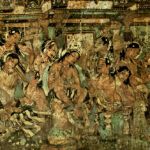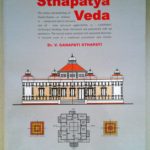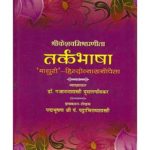Introduction
Art & Architecture is an essential aspect of any civilization. The notion of cultured living itself brings to mind not only material standards but also artistic ones as well. What does a civilization hold dear? What is the nature of its aesthetic? What is considered art and what is considered kitsch? All these things are determined by its fundamental approach to the fine arts.
In contrast to modern and post-modern society, the Indic approach to the fine arts is rooted in the Dharmic:

In India the cultural chain is never broken. The cardinal truths of life and conduct as incorporated in the Vedas in their characteristic style and symbolism also handed down in the Puranas, though the outward appearance seemed different. [2, 27]
An oft-cited critique of Indian art and iconography is that it is often “erotic” or even “grotesque”. Many foreigners (and foreign directed) often find it difficult to appreciate Indian art. Part of it is of course due to conditioned & close-minded bigotry, as the beauty of Ajanta Paintings should be obvious to anyone with sight, but part of it is also due to lack of sophistication. While Greco-Roman and neo-classical European art is often (rightly) praised for its outward beauty, clumsy comparisons with Indic art frequently ignore the aim of art itself.
The aim of art is to represent not the outward appearance of things, but their inward significance.
— Aristotle Quotes (@AritotleFact) November 17, 2017
As such, any aesthete or connoisseur should have the requisite training to understand what it is they are in fact experiencing. While some Indic art is obviously attractive and magnetic for obvious reasons, other pieces remain compelling in ways only connoisseurs (sahrdayas) can properly understand.
Our previous article on Sthaapatya Veda introduced the upaveda that includes Vaastu, Silpa, and Chitra within its category. In an interesting way, each sub-category is inclusive of the succeeding ones. Vaastu in general refers to Architecture, but this naturally necessitates an understanding of Sculpture and Painting. Similarly, Sculpture in general refers to sculpture in particular, but naturally necessitates an understanding of painting. One can therefore see that rather than an unrelated collection of alienated arts, there is a singular Integral Unity that pervades each of these. Like Indra’s Net, each one comes to reflect the other, while possessing its own individuality. Put another way, much like the famed matryoshka doll of Russia, each subject area contains a smaller subset within it.
As such, terminology is another area of importance. After all, words don’t often translate precisely. Often, a singular art or subject area becomes synonymous with an entire branch of knowledge. Just as Soopa Sastra represents Cuisine, just as Arthasastra represents Statecraft, just as Dhanur Veda represents the Military Arts, and just as Gandharva Veda represents the Performance Arts, so too does Silpa Sastra represent the Fine Arts.
“Architecture and Sculpture in India are very intimately related, the latter is rather hand-maid of the former.” [3, 209] Though often restricted only to Sculpture or image-making (pratima-kalaa), Silpa represents the Fine Arts in general, including Sculpture, but also Painting (Chitra), Pottery (Kumbhakalaa), Drawing (alekhya) & other forms of fashioning.

Terminology
- Silpa Sastra—Sculpture, Iconography, and Fine Arts in general
- Silpasaala—Art house
- Silpin—Sculptor, Iconographer, and Artist in general
- Sila—Stone
- Rupa—Form
- Rupakaara—Sculptor or fashioner of forms
- Murthi—Religious Statuary
- Prathima kalaa—Iconography/Image formation
- Prathima—Image/statuary
- Svadhiti—Chisel
- Mudgara—Hammer
- Phalaka—Wood
- Takshana—Carpentry
- Takshaka/Vardhaki—Carpenter
- Alekhya—Drawing & Sketching
- Lekhaneem—Pen
- Chitrakalaa—Painting
- Chitrakaara—Painter
- Chitra lekhana/varthika—Paintbrush
- Chitra-bhumi-bandhana—Canvas
- Laavanya— Delineation of Beauty
- Mudras—Hand gesture or Poses
- Sutragrahi—Engineer/overseer
- Kumbha kalaa—Pottery
- Kumbhakaara—Potter
- Maalakaara—Garland Maker
- Sankhakaara—Conch Maker
- Kabindaka—Weaver
- Karmakaara—Blacksmith
- Svarnakaara—Goldsmith
- Sphatika—Crystal
- Loha—Metal
- Suvarna—Gold
- Rajatha—Silver
- Thaamra—Copper
- Paittala—Brass
- Kaamsya—Bell-metal
- Aayas—Iron
- Saisaka—Lead
- Gaja-dhantha—Ivory
- Kadi-karkaraa—Brick & Mortar
- Thaalamana—System of measurement
- Thaala—Measure
Fine Arts

As previously mentioned, though primarily associated with sculpture, “Silpa may be said to mean all fine arts and crafts” [1, xxiv]. Therefore, to understand the Indic Approach to the Fine Arts, it is important to first fathom what a Fine Art is:
“A fine art presupposes the arousal of an aesthetic experience and aesthetic experience is based on the sentiments, the Rasas and Rasadrstis. According to Hindu view of Poetics and Dramatics as well as the science of Fine Arts, an aesthetic experience is not only a pleasure to the senses, it is not only toning up of heart and mind, it is something more, rather much more. It is elevating the soul. That is the spiritual background and it is in accordance with this fundamental tenet of aestheticity in India that writers on Aesthetics have likened an a[e]sthetic experience to the ex-perience aroused in Brahma-Realization-‘Brahmananda-svada-sahodarah’.“[2,47]
There are some who may protest the association of singular Silpa with Fine Arts in general. They will putatively point to the chatusasti-kalaa, or famed 64 Arts of Ancient India. But this too is subject to some degree of controversy. While the Classical Saastric 64 are well-known, Jain literature lists 72 and Yasodhara, an important commentator on Vatsyayana, listed as many as 512. [1, xxiii] In light of this, which number is correct?
It is said that Bharata muni himself resolved a similar controversy at the outset. Pointing out the differences between Arts & Crafts vs Fine Arts, he notes that the “art of love” or the “art of kissing” is obviously distinct from the Fine Arts (Silpa) or the Performance Arts (Gandharva). Therefore, the 64 Arts refer to the basic arts and crafts that eligible men and women should be expected to learn. A fine artist, that is, an exemplar of the aesthetics, was not a mere crafter of kalaa, but a steward of silpa. As such, kalaa refers to arts & crafts, Silpa refers to Fine Arts, and Gandharva refers to the Performance Arts. While these categories are obviously not mutually exclusive (as practitioners of chitra-kavya know all too well), this clarification will elucidate what differentiates them, furthering proper understanding in the process.
Theoretical Foundations
The theoretical foundations of the Fine Arts are of course rooted in Sthaapatya Veda. Nevertheless, a deeper dive is necessary before one can begin to evaluate key concepts.
The Philosophical Sources are of course obvious. As Sthaapatya Veda emerges from the Atharva Veda, it is only natural that Vedic philosophy would be foundation to the native Fine Arts of Bharatavarsha. Beyond that, however, are a number of key literary sources that serve as authorities guiding Silpis and Alankara Sastris to this day.
Of all the names in Sculpture and Iconography, it is Visvakarma who remains the most prominent. The Agni Purana refers to him as the creator of a thousand Silpas (Arts). Interestingly, he is said to have 9 sons called the Silpakaarinah. These were Malakaara, Karmakaara, Sankhakaara, Kabindaka, Kumbhakaara, Kamsakaara, Sutradhaara, Chitrakaara, and Svarnakaara. [1,xxi]
Chennakesava Temple, Belur, Karnataka
Indian Iconography is very vast. There are three principal sects: Brahmana, Bauddha and Jaina which have given rise to an innumerable host of Icons and Sculptures both in Indian monu-ments and our Silpasastras. [3, 209]
“Iconographical literature may be divided into the following sub-divisions:
1.Puranas 2.Agamas 3.Tantras 4.Silpa-sastras 5.Pratishta-paddatis 6.Dhyanas 7.Sadhanas”
[2,50]
While the Puranas are seminal to any study of Silpa, the Agamas provide technical details regarding the installation of various murthis, etc.
Among the prominent texts exclusively on Silpa is the Agastya-Sakaladhikara. Sakala is said to mean the word ‘icon’. [2, 59] Nevertheless, due to the overlap of Vaastu and Silpa, many texts mentioned in Sthaapatya Veda would be common to both. The Maanasaara devotes 20 chapters to sculpture, while Kasyapiya-Amsumad-bheda dedicates 39. [2,60]
Above all, however, are the many treatises that have come down to us simply as “Silpa Sastra”. Due to widespread destruction and loss of precious heritage in the North, most of the surviving manuscripts come to us from the South. Nevertheless, there is one recension of Silpa Sastra which comes to us from Odisha. It is Eastern India, therefore, that retains much of the native North, be it in dance (Odissi) or in this case, Silpa Sastra. Notably, there are 30 families of silpins in Puri. [1, i] The famed temple of Jagannatha unsurprisingly gives patronage to these artisans of ancient practice.
As for Personalities, there are numerous names cited as authorities on Silpa Sastra. These include numerous Vedic Rishis, but also many others, such as Utpala and Nagnajit. Some are legendary, others are ancient, and still others, such as Srikumara are more recent. This court silpin of Deva Narayana (ruler of North Travancore) lived at the end of the 16th century and was considered a great authority on Silpa Sastra via his Silpa Ratna. [2, 61]
While traditionally there two main schools, the Northern Nagara, and the Southern Dravida, history lends credence to more. The Great King Paramara Bhoja of Dhar was said to have developed a composite all India Hindu style. D.N.Shukla writes that this evolved out of the Lata style of the Gurjara School. The Chalukyas of Karnataka are said to have evolved a fourth school, which in turn influenced regions such as Warangal.
Alternatingly, more recent attempts to categorise the various schools of ancient art list Amaravati, Mathura, Gandhara, & Odisha as the main schools. These however do not conform to descriptions of various treatises, and the most up-to-date scholarship in fact considers Gandhara to be an outgrowth of Amaravati. Irrespective, Bhoja’s Samarangana-sutradhara was a great work of Vaastu, and in turn, Silpa. If it leans to the northern Nagara Style, the Aparaajitha-prccha of Bhuvana-devacharya leans to the southern Dravida. [2, 67] The dominating skylines of Madurai and Thanjavur, and their lovely statuary, would be influenced by it.
Key Concepts
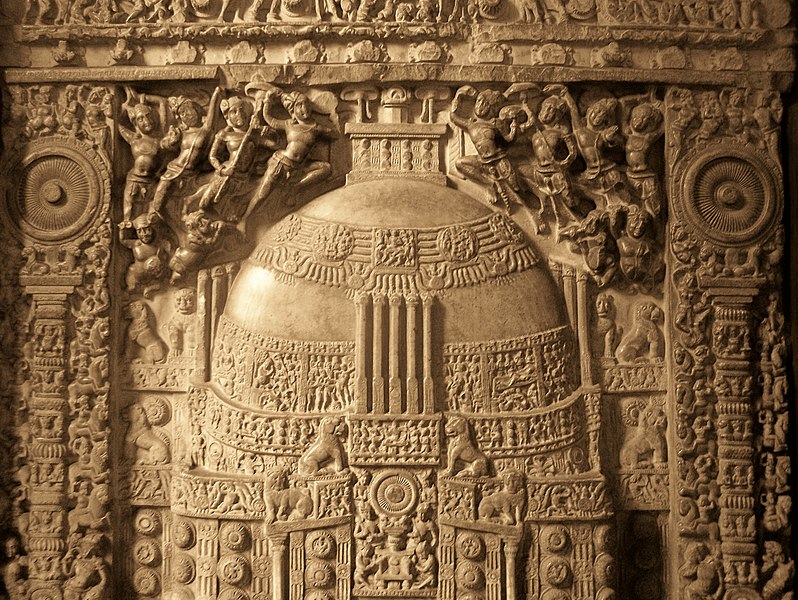
Art appreciation is a crucial aspect of understanding any theory of art. Just as oenophiles learn wine-appreciation from sommeliers and cork-masters, so too is art appreciation learnt ideally from the Silpa Sastris themselves, or failing that, from art historians.
Therefore, to properly appreciate Dharmic Art, one must gain familiarity with Key Concepts that are foundational to it.
Philosophy

The patron deity of the Indic Fine Arts is the Vedic god Tvastr. He is mentioned in the Purusha Sukta of the Rig Veda, and is alternately associated with many deities including Savitr and even Indra. Nevertheless, he is most often considered a form of Vishvakarma, himself the deity of Sthaapatya Veda and Vaastu Sastra.
This elemental connection to Purusha, with Tvastr conceived as emerging from the navel of Vishvakarma, delineates the centrality of the Divine to Dharmic art. Rather than mere interaction of matter, it is the concept of Supreme consciousness that pervades and sparks material reality. Art too, therefore, is a result of attempting to realise the divine, rather than simplistic expression of human caprice. Having understood this, one can begin to grasp the aesthetic motivating the artistic Indic.
Aesthetics
Indic Aesthetics is a topic that has inspired myriad authors and numerous books. The ancient Aestheticians raised it to a very great height that is only again now being properly conceptualised. Though often mis-translated merely as Rasa, the correct translation of Aesthetics is Rasalankara—that is, the beautiful experiencing of sentiment. As such, beauty must be married to sentiment to be properly experienced in a resonating fashion. There are a plethora of concepts attached to the branch of knowledge known as aesthetics. However, for the time being only Rasa-bhava and Dhvani will be discussed.
Rasa-Bhaava
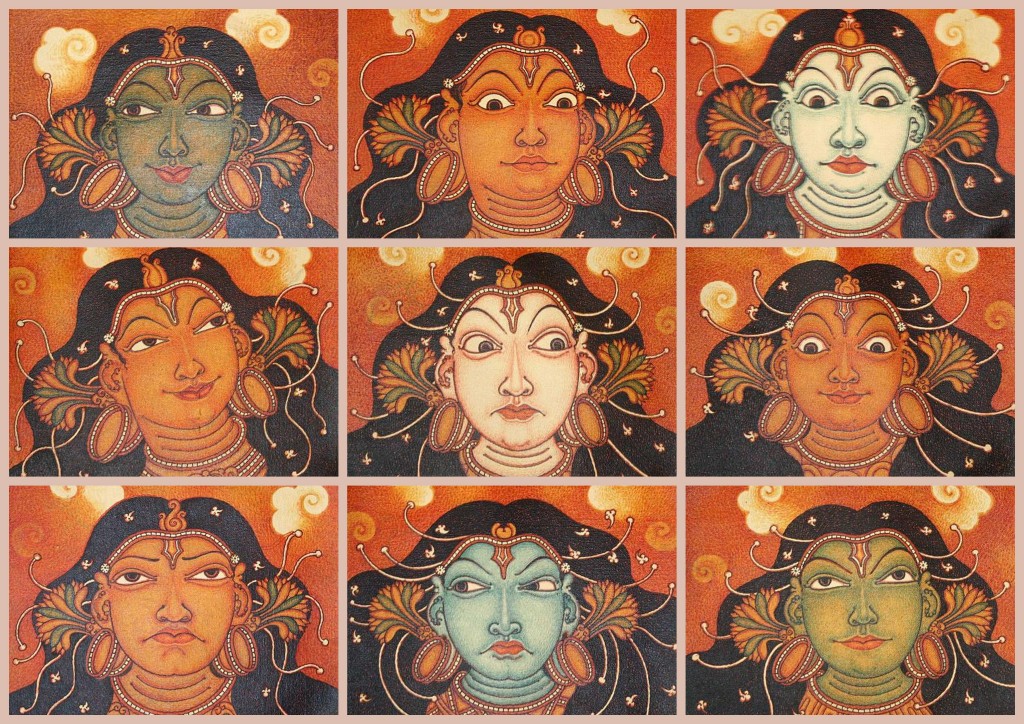
Bharata Muni’s celebrated expatiation on the 8 rasas (which eventually added another to become the Nava Rasas) is known from his legendary work, Natya Sastra.
Rasa theory is the outstanding contribution of Classical India to World music, dance, and above all literature. This sentiment is the lasting impression or feeling of the author that he/she aims to impress upon the audience. These are nine in number (hence the term Nava Rasa): Sringara (Romantic), Veerya (Heroic), Haasya (Comedic), Karuna (Pathos), Raudra (Furious), Bhayaanika (Frightful), Bibhatsa (Loathsome), Adhbuta (Marvelous), and finally Shaantha (Calming).
The Sthayibhaava is the leitmotif or permanent sentiment of a composition. There are generally eight in number, based on eight of the nine rasas. They are as follows: rati (erotic), haasa (comic), shoka (sorrowful), krodha(angering), utsaha (enlivening), bhaya (frightening), jugupsa (disgusting), and vismaya (amazing). A ninth, sama (tranquility), is associated with Shaantha.[7]
Bhaava is the complete affecting of the heart by any emotion. Rasa means sentiment, sthayi bhava means dominant emotive state, and vyabhichari bhava means transitory or transferable stages.”They are the instrumentalities of conveying and communicating intangible but real states of mind.”[8,9]
But as we discussed elsewhere, mere paint by numbers alone is insufficient to experience Rasa and Soundharya (beauty). Much like a Dance performance or a Musical performance or a work of literature, a work of art must possess Dhvani (resonance). What is it that causes dhvani is a topic for another time and another place and another aesthetician known as Anandavardhana. Nevertheless, for our purposes here, for a work of art to truly capture the mind it must have dhvani, so as to draw in the observer, who need not be told of why such and such a piece is truly great. He or she can experience it.
Motifs

There is also remarkable continuity in motifs from one end of Bharat to another. This is the case not just within India, but in the greater Indosphere. Symbols such as the Dharmachakra, the feet of divinities, the Thoranas (archways), and so on, find their way across both subcontinent and continent.

One motif is in fact so pervasive and expansive, it deserves its own section: the Mudra.
Mudras

Mudras are known as postures. In recent times, due to the popularity of Yoga and the like, Mudras have become synonymous merely with the hand. These are, however, merely hastha-mudras (hand postures). The fuller meaning of this term is posture, thereby beginning with the body itself, before expanding to parts of the body.
Mudras are divided into hastha-mudras (hand), sthaana (body), and paadha-mudras (leg)
There various hastha-mudras, but these can be discussed elsewhere, but here is a brief list of various types of various postures:
Hastha-mudra — 24 Asamyutha hasthas, 13 Samyutha Hastas, 29 Nrtta Hasthas
Sthaana — 9 total based on attitudes, for which Bhojadeva gives 3
Paadha-mudra — Sthaanaka (standing ), Aasana (sitting ), Sayana (reclining)
Thaalamana
“Icono-planning is not only a ritual but also a scientific prerequisite before fashioning an image out and therefore any planning, if it is scientific, must start with the correct proportions as handed down in the Sastras.” [2, 94]
Measurement is a pivotal part of sculpture in particular, and art in general. The painter may be able to paint over a specific portion, but the sculptor must take exquisite care in preserving the stone he is working on. One misstep may mar a murthi, preventing worship of the icon.
Thaalamana (system of measurement or iconometry) ensures that a silpin has direction when crafting his work. Standardisation of measures found in the Sarasvati-Sindhu Valley has long been a matter of wonder, but what is more interesting is the standardisation of measurement across sastras. Both Dhanur Veda and Silpa Sastra stress the use of measurement using angulas (finger breadths). Interestingly, both feature many of the same paada-mudras as well.
With respect to sculpture in particular, the direction provided by Agama and Silpa Sastra ensures not only the longevity of the prathima (through minimised breakage) but also that the precise proportions are preserved for the prana-prathista of a murthi. This explains not only why the particular forms (rupas) are the way they are, but also why they are replicated with such exact frequency throughout the Indian Subcontinent.
Samaranga Sutradhaara gives the following unit measurement table [2, 86]:
3 parmaanus = 1 raaja. 8 raajas = 1 roma. 8 romas = 1 liksa. 8 liksas= 1 yooka.
8 yookas= 1 yava. 8 yavas=1 angula. 2 angulas = 1 golaka. 2 golakas = 1 bhaaga (part)
Jeernoddhaara

As discussed in our article on Sthaapatya Veda, renovation of old art and architecture is nothing new to Indic Civilization. While there are certain rules regarding the worship of religious icons, for which formal abhisheka and archana may not take place, art and architecture in general is another matter.
The concept of Jeernoddhaara (renovation of old or dilapidated art & architecture) [2, 163] is critical one, especially in the present time. Though it naturally encompasses the process through which old murthis can be re-consecrated, it has a wider connotation. It is discussed in Vaastu Sastra and remains a matter of import not only for renovating old works of art and architecture, but in renewing ancient cities.

There are numerous other concepts to discuss, but for the purpose of this brief Introduction to Indian Art, these will suffice. Silpa, after all, may refer to all the Fine Arts, but is, more than anything else, about sculpture.
Sculpture & Iconography
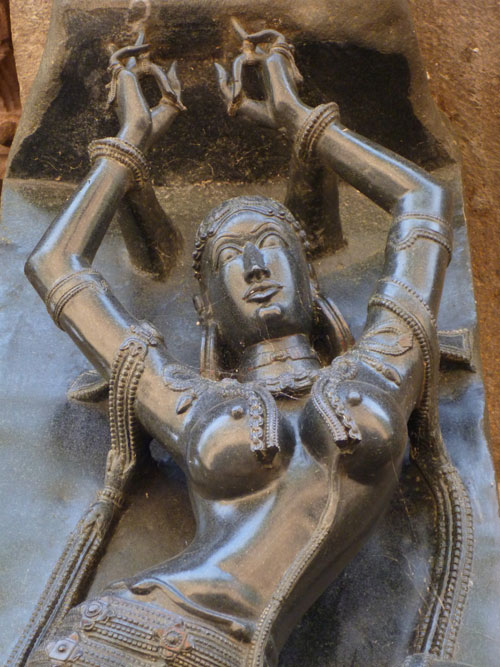
Leaving aside Silpa Sastra, Sculpture itself is a large field that naturally includes iconography. While painting (Chitrakalaa) can be discussed at another time, it is important to stress, as intimated above, that painting as Fine Art, comes under the purview of Silpa Sastra.
Each culture or civilization (mega-culture) may take on certain conventions or ideals, but behind the most sophisticated forms of sculpture, is an approach or theory of sculpture.
Theory of Sculpture
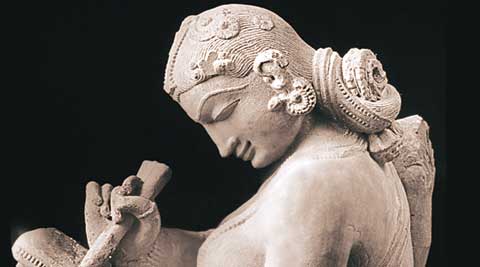
Indian Sculpture is nothing but an Iconography, par excellence— Devas, Gandharvas, Kinnaras, Yaksas, Apsaras, along with the sy-mbolic manifestations and Subjective symbolisations of so many mental and spiritual attitudes standing for our emotional edifica-tion and cultural integration that become temple icons and sculptures. [3, 209]
Literature on Vaastu & Silpa lists at least 10 different materials for the purposes of sculpture. These include clay (mrna), wood (phalaka), copper (thaamra), iron (ayas), silver (rajatha), gold (suvarna), and various precious stones (ratna). [2, 40]
A detail procedure for wax-models for metal casting is also stipulated, particularly in texts like the Silpa Ratna. Clay compounds are discussed based on the metal type. These clay compound types are as follows: katina (hard), mandha-katina (medium-hard), mrdvi (soft), mrduthara (softer), and moosaakarana-yogya (clay fit for a crucible). [2, 111]
The stones or materials themselves should have certain auspicious signs. These are padmakaara, svastika, sankaabha, chakrasannibha, chatraakrthi, dhvajaakaara, trisulakrthi, matsya-makara-koormabha, govrsabhaakrthi, vajra-khadgaakrthi, dandaabha, chaamaraakrthi.
Stone types
Various varieties of stones are listed. As is well know, all sorts of stone from sandstone to marble to everything in between have been utilised by the Silpis of old. But these can be better discussed in a separate article.
Other than the variety of stone, there is distinction of stone colour and how it should align on the basis of one’s way of life. White, Red, Yellow, and Black stone are recommended based on one’s varnadharma. The individual stone specimen itself could vary by age, and this too is treated by the various texts on Silpa Sastra. Yuva (youthful) and madhya (middle-age) are the two that could be used for religious iconography, while baala (very young) and vrddha (old) were listed as not appropriate.
This in turn dovetails from sculpture to the sub-branch of iconography.
Approach to Iconography
Iconography is both a science and an art. An art must express life in all its manifestations. Images and sculptures, the finest productions of art, naturally therefore, must express life. [2, 117]
Iconography deals specifically with religious Icons, originating from the Greek eikon (object of worship). It deals with religious icons (statuary and otherwise) as well as the detailed process involving creation and establishment. As is fairly well known among Hindus, the murthi-sthaapana (installation of statuary for worship) is very detailed and precise in the procedure stipulated.
Images of divinities are classified as follows: Chitrajaa (painted), lepyaja (clay), Paakaja (cast metal), and Sastrotkeernajaa (carved by metal instruments). There is an additional classification provided by Gopala Bhatta that is more all encompassing:
1.Mrnamayi (made of clay) 2.Daaruja (made of wood) 3. Lohaja (made of metal) 4. Ratnaja (made of jewels) 5. Sailaja (made of stone) 6. Gandhaja (made of pastes, like sandalwood) 7. Kausumi (made of flowers [2, 96]
Painted icons are found typically on canvas, wall, or stone. As per the Silpa-ratna, clay icons are of two kinds martika (burnt/kiln-fired) and ammartika (unburnt). Each metal or stone or ancillary material is imbued with significance.
Furthermore, iconography(pratima-kalaa) require an even more rigorously trained sculptor
The iconographer must be adept in the sastras and endowed with insight and lead a life of perfect brahmacharya and the samyama (control over his senses). Before taking up his sacred task of giving a murta, the manifest form to the amurta, the non-manifest one, of the gods—the presiding deities of the destiny of mankind, he should perform the sacrifice and then start japa in order to purify himself of all the secular impurities, so that his hands may be in complete union with the spirit and the mind. A code, indeed of religious discipline, is prescribed. [2, 83]
There are organic variations within the various Dharmic sampradayas regarding religious icons. From a gold pendant featuring the Vedic aum to the massive 57 foot tall Jain statue of Gomatesvara in Sravanabelagola, icons come in varying forms and sizes. Worship and reverence for them takes place in different ways and for different reasons. However, the distinctions between Vedic, Buddhist, and Jain iconography (as well as Sikh art in general) are better discussed elsewhere. How the ancient Sastras seep into modern artistic and spiritual experience, remains more important.
image-worship…was a grand religious and philosophical solution of the difficulty of conceiving a limitless Absolute from the practical point of view and the conveniences thereof. A reconciliation of Vedantic or idealistic philosophy of the Upnisads with the image-worship, representing polytheism, has been strikingly effected in the National Religion of this ancient country. [2, 29]
Important Texts
Silpa Sastra
Agastya-Sakaladhikara
Kasyapiya-Amsumad-bheda
Maanasaara
Puranas—Agni Purana, Matsya Purana, Vishnudharmottara Purana
Agama—Pancha-ratra, Sapta-ratra, Vaikhanasa
Tantra—Hayasirsa, Trilokya-mohana, Vaibhava, Pauskara, Naradiya, Sandilya, Vaisvaka, Saunaka, Jnana-Sagara-Vasistha, Prahlada, Gargya, Galava, Svayambhuva, Kapila, Tarksya, Narayaniya, Atreya, Narasimha, Ananda, Aruna, Baudhayana, Visva
Chitra-lakshanam of Nagnajit
Aparaajitha-prccha
Samaranga Sutradhara of Paramara Bhoja
Silpa Ratna of Srikumara
Personalities
Vishvakarma
Mayasura
Nagnajit
Maharishis—Vasistha, Atri, Narada, Garga, Kumara, Saunaka, Visalaksa, Kasyapa
Sukra
Brihaspathi
Prahlada
Paramara Bhoja
Bhuvanadevacharya
Srikumara
Conclusion
From the famed statuary of Khajuraho to the modern era works of Raja Ravi Varma, the Indic Fine arts have found expression in a myriad ways, manners, styles, and mediums.
In the coming months (and years), we will continue with this introductory overview and study the the various elements of Silpa Sastra, as well as the subsidiary Fine Arts associated with it.
As we have seen with this article, Silpa Sastra covers not only a wide array of topics beyond sculpture, but represents the authentic Indic approach of “Integral Unity” in all facets of life. [9] Rather than deconstructed alienation and surface-level appreciation of the superficial, the Indic Fine Arts forces us to look within, and appreciate the inward significance rather than mere outward appearance. There is beauty in all things, both the ordinary and extraordinary, the haasya and the bhayaanika, the written word and the sculpted form. This has been the driving philosophy of native Indic Civilization since its inception. While it appreciates the worldly accomplishments of man, it looks ultimately to the Divine as the inspiration and driver of all things. This consistent approach to art can be seen from Kashmir to Kanyakumari and from Arbuddha to Assam.
More than anything else, the pervasive influence of Indic art is seen throughout Asia. Whether it is Turkistan or Malaysia, there is a wide impact of obvious Dharmic motifs and outright Hindu inspiration. The influence of the Silpa Sastra and even Samaranga Sutradhara spread far and wide.
Pramaane sthaapathi devaah pujaahrscha bhavanti hi Ch.40, sl.13
Gods and goddesses become fit to be worshipped only when they are set up with correct proportions. — King Paramara Bhoja

Nearly all the artistic remains of ancient India are of a religious nature, or were at least made for religious purposes. Secular art certainly existed, for literature shows that kings dwelt in sumptuous palaces, decorated with lovely wall-paintings and sculpture, though all these have vanished. Much has been said and written about Indian art since, some forty years ago, European taste began to doubt the established canons of the 19th century and looked to Asia and Africa for fresh aesthetic experience. Since then most authorities on the subject, Indian and European alike, have stressed the religious and mystical aspect of Indian art. While admitting the realism and earthiness of the earliest sculpture, most critics have read the truths of Vedanta or Buddhism into the artistic remains of our period, and have interpreted them as expressions of deep religious ex-perience, sermons in stone on the oneness of all things in the Universal Spirit. [6, 346]

References:
- Kumar, Pushpendra Ed. Silpa-Sastram. Delhi: Eastern Book Linkers.2006
- Shukla, D.N. Vastu-Sastra (Vol.II): Hindu Canons of Iconography and Painting. New Delhi: Munshiram Manoharlal Publishers. 2003
- Shukla, Lalit Kumar. A Study of Hindu Art and Architecture (with special reference to the terminology). Chowkhamba. 1972
- Gaur, Niketan. Sthapatya Ved-Vastu Sastra: Ideal Homes, Colony and Town Planning. New Delhi: New Age Books. 2009
- Vatsyayan, Kapila. Kalātattvakośa V: Forms. New Delhi: IGNCA. 2002
- Basham, A.L. The Wonder that was India.New Delhi: Rupa & Co. 1999
- Vatsyayan, Kapila. Bharata: The Natyasastra. Sahitya Akademi.2007
- Kale, M.R. Dasakumaracarita of Dandin. New Delhi: MLBD. 2009
- Malhotra, Rajiv. http://www.firstpost.com/living/rajiv-malhotras-indras-net-seven-big-ideas-and-hinduisms-integral-unity-2382902.html










